Are you comparing 300 AAC Blackout to 5.56 NATO? If so, you’re doing it wrong. Sort of. You see, 300 BLK wasn’t intended to replace or compete with 5.56/.223 so much as with good ol’ 9x19mm Parabellum . . .
Apples and oranges? An absurd comparison? TTAG’s Instagram and Facebook audiences sure had some strong opinions (some knew what was up). Handgun round vs. rifle round and all. Right? Not always.
It’s all about the SMG — the submachine gun. That’s a little carbine type job that fires a pistol round instead of a rifle round. They’re used for CQB — close quarters battle — and as PDWs — personal defense weapons. Close-in, quiet, low recoil, low blast, compact size.
Where 300 Blackout was meant to fill a niche was as a replacement for the pistol caliber SMG. Not, as many tend to think, as competition for the M4 (5.56 NATO AR-15 carbine).
Special Operations has loved them some MP5SDs since before Millennials were born. They’re great for use inside of buildings and other small spaces — clearing rooms, ships, what-have-you. But exit that building out onto the streets of some urban combat zone, and suddenly you’re horribly out-gunned.
Getting engaged by a few guys with AKs on a rooftop or behind a vehicle 300 meters away? Forget it. Subsonic 9mm ain’t your jam. In fact, you’re the one in a jam.
Cue the original LVC, or Low Visibility Carbine. Also known as the AAC Honey Badger. This PDW was designed to be as quiet as the MP5SD but with three times the effective range, all in a lighter weight, slightly more compact form. With much better accuracy.
For those stealthy CQB or home defense scenarios, run subsonic rounds — typically 185 to 220 grain projectiles at around 1,000 feet per second. While this doesn’t provide a whole heck of a lot of muzzle energy — about 465 ft-lbs, which is equivalent to .45 ACP or about 42% more than that subsonic 9mm — it does have other advantages over 9mm. Namely, higher sectional density for improved penetration and sleeker ballistics, plus massive expansion capability.
From big names like Hornady to more boutique manufactures like Black Butterfly, Discreet Ballistics, Underwood, Gorilla, and more, there is no shortage of subsonic 300 Blackout rounds designed to expand reliably and dramatically. These loads have proven themselves highly effective on hogs and deer that nobody in their right mind would attempt to take with any 9mm.
For longer engagements, run supersonic rounds — typically 110 to 147 grain projectiles at up to 2,400 fps. This expands effective range to about 440 meters thanks to significantly more aerodynamic bullets leaving the barrel at 240% the velocity of those 9mms. All with vastly superior accuracy than the MP5SD’s 6 to 9 MOA “accuracy” at 100 meters.
Plus, the 300 BLK arrives at 300 meters with around 625 ft-lbs of energy. That 9mm? Like 145 ft-lbs.
Simply changing out magazines is all that’s necessary to switch between subsonic loads and supersonic 300 BLK. In the time it takes to swap a mag you’ve gone from incredibly quiet CQB PDW to combat effective carbine. Unlike a 9mm SMG, a 300 BLK PDW won’t leave you with your pants down.
Today’s version of that original AAC Honey Badger concept is the Honey Badger by Q, and it sports a 7-inch barrel length whether in SBR or pistol form. It’s a 1-3 MOA gun depending on the ammo (I’ve found both supersonic and subsonic factory ammo that puts up 1-minute, 5-round groups at 100 yards from the Honey Badger). With subsonic loads, it’s just as quiet as you’d hope.
The Honey Badger weighs 5 lbs 5 oz on my kitchen scale. That’s sans magazine and optic, but that includes the suppressor (of course). A [new] MP5SD weighs in at 7 lbs 8 oz. Q’s Honey Badger is the same length as an MP5SD.
If you aren’t shooting suppressed that’s okay, too. Q’s Honey Badger is still MP5-sized but it weighs less and can fire a capable rifle round.
In a comparison of 300 Blackout vs. 9mm for use in a PDW / SMG, well, there really isn’t any comparison. Despite the fact that 300 BLK vs 9mm, not 300 BLK vs. 5.56 NATO, is the more appropriate comparison to make since taking down 9mm was the cartridge’s primary focus. Which is probably why we haven’t seen M4s replaced by 300 Blackout carbines in the military but we have seen MP5SDs replaced by 300 Blackout PDW-style guns in Special Operations units.
The clear winner here: 300 AAC Blackout. Chambered in the right firearm it does everything the MP5SD can do — but better — in a 28% lighter package with the same footprint, then it adds full-on carbine capabilities on top. Our old friend, the 9mm, didn’t have a chance.
Then again, 9mm will always have a place in handguns, and its popularity in pistol caliber carbines isn’t going anywhere as it’s so cheap and fun to shoot. It will always outsell 300 BLK by many orders of magnitude. Perhaps it’s not so much that 300 BLK beats 9mm, but that it makes the submachine gun obsolete.

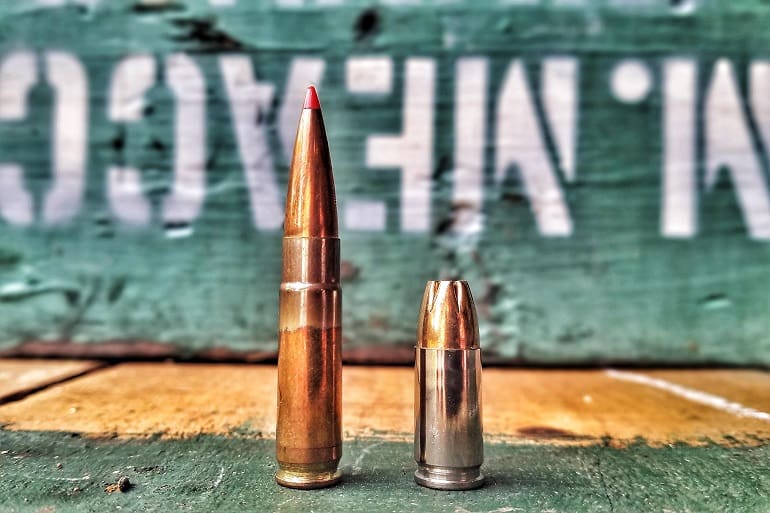
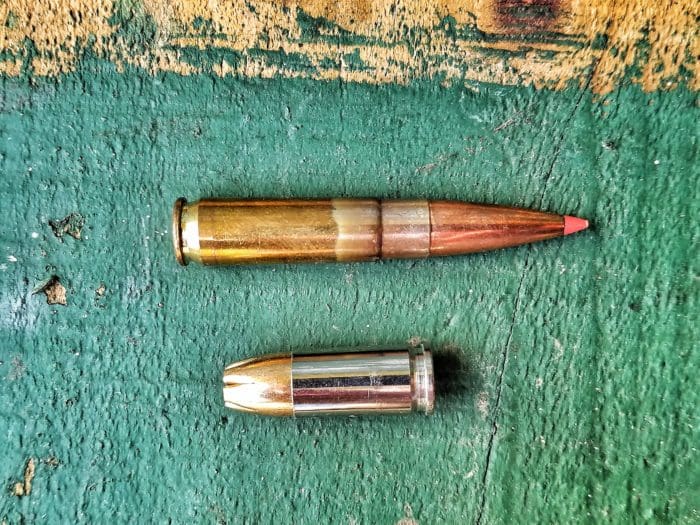
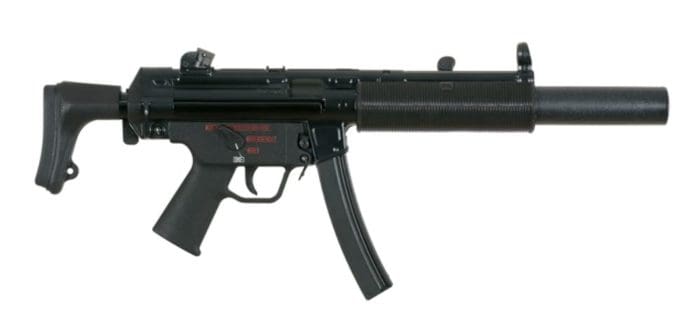
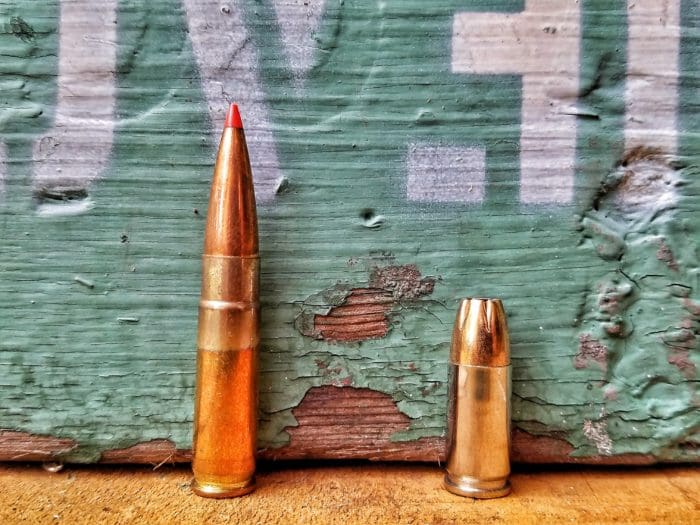
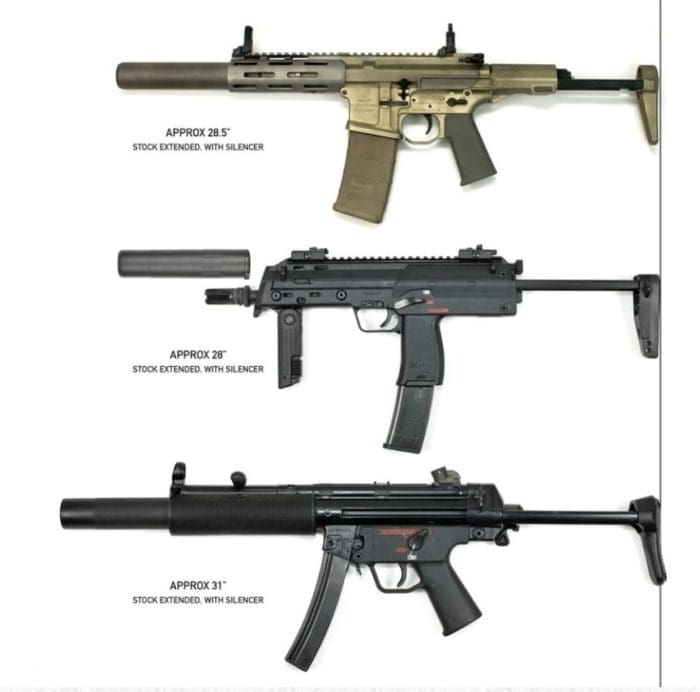
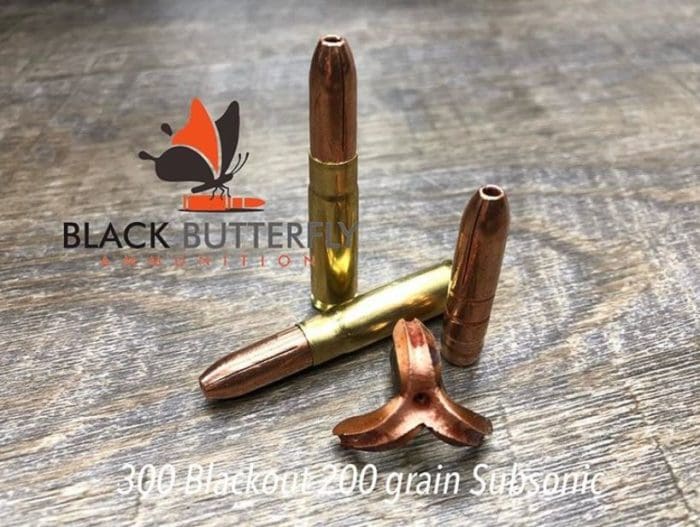
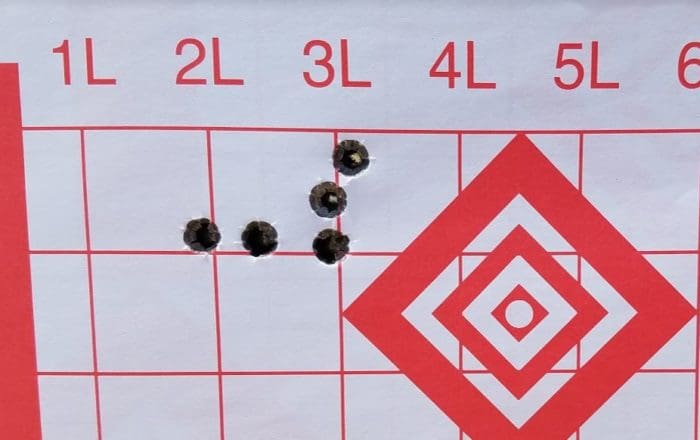
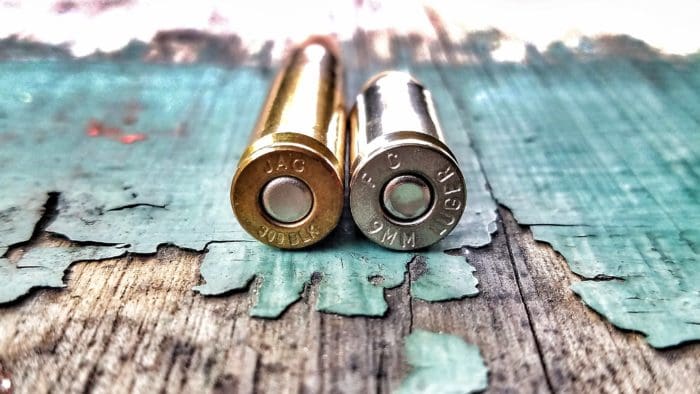
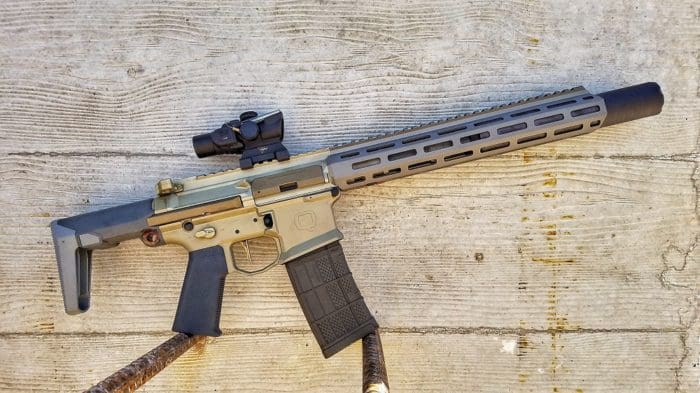

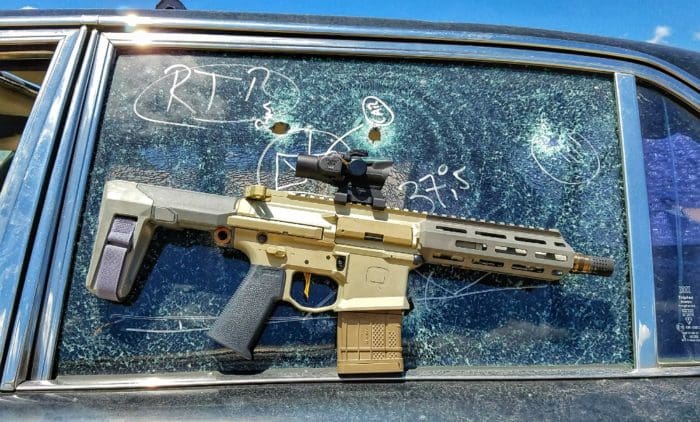
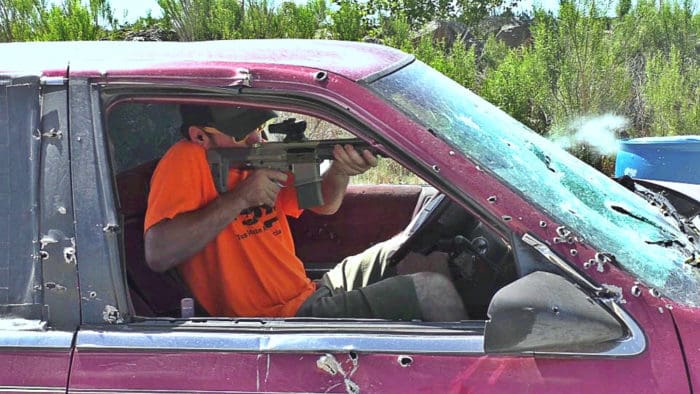
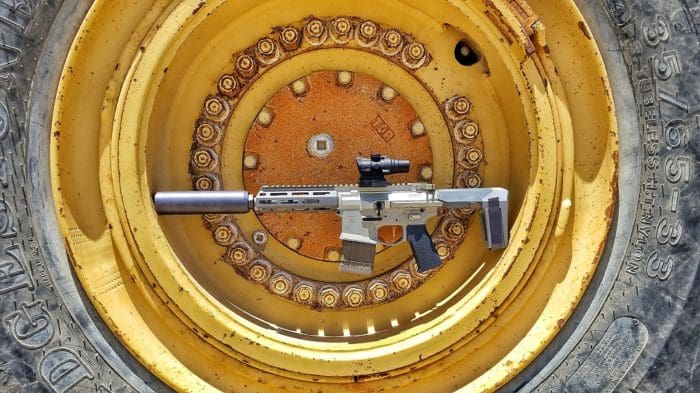




The main counter to your argument would be micro-SMGs like the MP5K or Kriss Vector, while I agree that the PDW role is better served by a PDW dedicated cartridge like .300 AAC or 5.7×38, I would argue that neither of those cartridges can be squeezed down into a machine-pistol / micro-SMG platform. It’s a niche weapon for when a pistol isn’t quite enough, but even a small carbine would be inappropriate for the mission profile. (Such as VIP protection.) My next full blown gun will probably be a PS-90 SBR or failing that, I might put in a tax stamp to put an A3 stock on my MP5K clone.
Werd. It ain’t a machine pistol.
BTW a P90 in the shorty barrel length is 20″ long without a suppressor and weighs 5 lbs 13 oz. The Honey Badger is 26″ long with the stock collapsed with the suppressor and weighs 5 lbs 5 oz. We aren’t exactly worlds apart here. Especially after you add a suppressor to any of the micro-SMGs you mentioned.
Go out and shoot that Honey Badger with subs full auto vs that P90 full auto while you are walking. You’ll see the 300BLK gun doesn’t hold a candle to the P90.
SMG’s are about shots on goal.
Yes, well Mr. pwrswerge ain’t looking at a select fire build. BUT, you’re 100% correct. I have actually shot these calibers full auto and those 220 grain 300 BLK subs push back hard. The strength of the muzzle climb has always surprised me on this setup, as I expect such gentle recoil from the subsonic ammo but that really isn’t the case at a high rate of fire.
The same principle applies to followup shots in semi-auto. I can dump a magazine from my MP5K with a brace into a 6″ circle in a couple of seconds at 15 yards. I don’t think I could do that with 220gr 300 AAC.
The beauty of the PS-90 is that the gun basically doesn’t move under recoil. If somebody made a good light weight / short reset trigger pack for it, I’d already have one in my safe.
But you’re right a PS-90 is not a machine pistol. I should have been clearer on that.
But but but… with these 220 grain pointy things you won’t need to put a whole mag on target like you might with the 115 grain FMJs they fire from the MP5SD 😉
FWIW, I bet you could actually dump a mag of 300 BLK subs in that target at that range.
Uh… since when were 200 or 220gr 300BLK difficult to keep on target? Even at 50yds, I have no problem moving, dumping the mag, and staying on target. Granted, it isn’t as light as 9mm or 22lr, but it isn’t exactly uncontrollable by any stretch.
Wow! This totally validates my decision to make my next AR build a pistol in 300 BLK. I may even go for a tax stamp and get a suppressor.
It lives to be suppressed! I think the Nomad is my current favorite .30 cal can: https://www.thetruthaboutguns.com/2018/10/jeremy-s/hands-on-with-dead-airs-new-nomad-30-suppressor/
This convinced me to do a glock build in .300 black.
Theres only one problem with that idea: it should be built in 6.5 Creedmoor.
A Glock…in 6.5 Creedmoor.
Singularity.
🙂
Interesting comparison. I always thought of .300 AAC Blackout as a possible replacement for 5.56 x 45 mm NATO. (The idea being that it would produce the same ballistics as 7.62 x 39 mm communist bloc platforms in AK-47 carbines/rifles.)
Fun (and very important) question: do .300 AAC Blackout barrels have a twist rate that stabilizes 220 grain bullets at 1,000 feet per second without “overstabilizing” 110 grain bullets at 2,400 fps?
I don’t think I believe in overstabilizing. Not until you get to the point where bullets are spinning so fast that jackets come off. The Q Honey Badger has a 1:5 twist. I’ve shot lots of 1 MOA groups from it. 300 BLK was tested down to 1:2 twist rates without seeing pressure spikes. I think the vast, vast majority of 300 BLK guns have 1:7 twists. If that’s fine for a 55 grain .223 (which it is), it’s fine for a 110 gain 300 BLK.
Sig’s tight twists on the MCX were over spinning Lehigh 78 grain high velocity bullets so bad they were coming apart. They stopped making them for a little while because of it. So yes, at 110 grain it’s not an issue but there are cases when you can have too tight of a twist rate.
I once pushed a .22 bullet designed for the Hornet(I believe it was 36 grains) out of a .22-250 at near 4200 fps. Didn’t have a chono then(the 1980s) so it was measured via mathematics and a pendulum. The thinking was that the extremely light projectile would expand very violently on varmints.
Anyway, the velocity was irrelevant since I couldn’t sight the gun in on paper. It really had me scratching my head when I couldn’t print a group on paper. They expanded violently all right. My befuddlement ended when I just shot the loads at a backstop with no paper and the slugs hit like a shotgun pattern. The bullet fragments left behind when they came apart in midflight were too small to even make it to the paper.
And that was with a completely ordinary twist rate, I think maybe 1 in 12. Weird things happen when projectiles undergo such extreme centrifugal forces. And its not only the twist rate. As you push the projectile faster, its RPM increases in direct relation to the velocity(double the velocity is also double the RPMs, and so on).
.357 magnum. Best of both worlds. Carry a revolver AND a lever action carb ine chambered in it.
Now you are talkin!
357 is awesome in a handgun and nuclear in a carbine.
You have no idea how badly I want a compact semi-automatic carbine with a 16-inch barrel chambered in .357 Magnum. (And it would have to come with 20 round magazines.)
That would hit REALLY hard at close range. Muzzle velocity for a 158 grain bullet would be near 2,100 fps (1,547 foot-pounds energy). And all the way out to 200 yards, that bullet would still be travelling at 1,310 fps (600 foot-pounds energy). That would be a serious manstopper.
I love .357 Mag and it’s awesome and fun in a carbine, but if you want a semi-auto and want a projectile in the 150 grain weight range at those velocities the 300 Blackout gets very close to that (150 grain at 2,000 fps). Except with the significantly higher ballistic coefficient of the projectile you’re going 300 fps faster and 875 ft-lbs at 200 yards vs. with the .357 Mag.
Definitely not as cool, though.
And it doesn’t come with that nifty lever at the bottom.
I’d kind of like a 10mm semi-auto ca rbine with a magazine that feeds up the grip, but the only one I can think of is the High-Point. I was thinking something more like the Beretta CX4. I doubt the 10 performs as well as the .357 in a longer barr el but it’s close enough.
BTW, speaking of Beretta, if anyone is wondering what to get the Gov for Christmas… http://www.beretta.com/en-us/sso6-eell/
The SBR version of the vector handles 10mm quite well in a fairly tiny machine pistol sized package.
Still loads up front, which IMHO you might as well use something with a little more steam like 5.56 or .300 Blackout. And you’re looking at what, an 8″ ba rrel? I’m looking for something more compact than a non-NFA AR but not a machine pistol. I want 16″ of barr el to get the most out of the 10.
@Serge
If I could get a Kriss in the 5.5” machine gun, 10mm flavor, I’d die happy. The two round burst with 10mm, slap on those kriss G21 mag extensions, and you’ve got a massive win. Kris’s was supposed to get 10mm dedicated extensions for the G20 mags, but haven’t looked at it in a while.
10mm that feed from the grip and 16 inch barrel — Mech Tech Systems pistol “upper”. http://mechtechsys.com/
The down side is you still need a working pistol frame to mate with the upper.
Uncommon Sense:
Be aware that any time your desire is for a rimmed round fed through a detachable box magazine, you are setting yourself up for a tremendous amount of feeding headaches down the road. Not that it is impossible to do, but feeding rimmed rounds through a stack into an autoloading action is just inviting trouble to come and camp on your doorstep.
Where are all those rims going to go as you stack them up? There are only three answers to that, and all invite feeding troubles. Either the rounds have to stack behind each other by the thickness of the rim, slanting rearward(like the Enfield, which is only 10 rounds and not autoloading), or they have to stack straight on top of each other, meaning a lot of taper to the round, which then also means a lot of forward curve will be required in the magazine(think Chauchat magazines, the shape required for feeding the rimmed 8mm Lebel), or the mag can be made much thicker through the rear portion, and hold the rounds by pinching the fronts and just letting the rear, rimmed areas flop around as they desire, the way the Walther P-22 mags work.
If you think about those three problems, and how one might get around them, you will be relearning all that the arms industry learned over a century ago. Namely, that autoloaders fed by box mags really require rimless rounds, which is the reason they were invented in the first place. To get around these feeding problems that no one ever could manage to do satisfactorily with rimmed rounds.
None of this applies to tube magazines, or belts, or hopper feeds, or any other feeding systems other than box mags. But, its box magazines that everyone seems to desire, so that requires either rimless rounds(or endless fiddling) to get them to work properly.
Rebated rim rounds(like the .460 or .50AE) open up a whole new box of snakes. Again, unless certain ones like endless fiddling to get them to work properly, they should just be avoided in autoloading, box magazine fed, firearms(but for different reasons that I won’t go into).
My Coonan says otherwise.
Kenneth,
Potential (likely?) box magazine trouble with .357 Magnum cartridges could be a huge drawback needless to say.
Of course the simple solution is to make an almost identical .357 Magnum cartridge that is simply rimless!
And you find that your Coonan shoots without feeding malfunctions? Without fiddling with your magazines to get.. say.. even two or three mags w/o a feed stoppage? Don’t just assume that every gun has feeding malfunctions “every once in a while”, but instead just answer the question properly.
Just how many times do you shoot that Coonan with, say a hundred rounds, versus how many feeding malfunctions do you get with that one hundred rounds? NOTE: I’m not attacking Coonans. They are a fine and well built firearm, and, IMO, worth their high price tag. But even so, in my experience, they still suffer from the feeding problems of a stack of rimmed rounds, the same as the Colt Gold Cups in .38 wadcutter(another specialized and expensive firearm) did, way back when.
OFC, if the particular game one chooses to compete in does not count gun malfunctions against one’s score, but instead offer that one a reshoot anytime a gun malfunction occurs, well…. in that case firearm reliability doesn’t much matter does it? On the other hand, if I have an opponent who won’t stop shooting at me just because my gun fails to function, well now I want as much mechanical reliability as I can get, up to and including 100 percent, which is obviously not possible. Every machine dreamed up by man will fail, sooner or later. Even if only when it is completely worn out.
IOWs just what percentage of those rounds feed properly in a given 100 round string? 99? 89? 79? NOTE: I do not accept answers to math questions like “enough” or “a few”, or any answer other than a number, as in X percent, where the X is an integer, perhaps followed by fractions or POINT something percent of an integer. IOW, no answer similar to: “Its fine”, “its good enough”, etc., can be acceptable to a math question. It involves numbers and math, and so the correct answer MUST be a number.
There is already a rimless cased .357. It’s called the 38 Super(among many other names…) and it goes all the way back to the 1920s. It used to suffer accuracy problems due to headspacing only on the extractor.
Luckily, that problem is much easier to solve than a tall stack of rimmed rounds. Just rebarrel to a shorter chamber that then headspaces on the case mouth, the same as almost all other rimless, straight walled cases do. Gotta love a fix that’s so simple, even if it did take 40 years or more to actually accomplish. One thing I have noticed about people, everything takes forever… until they become heavily motivated, at which point things seem to become almost instant, compared to their glacial speed back when it was all just about the argument. Unfortunately, when they come off glacier speed, they also leave all brain function behind and accuracy and functionality then go to almost zero. It’s too bad they can’t find a speed at which things do get done, but with somewhat more intelligence than the average tree frog.
Don’t take any of this to heart, I’m just ragging on the great unwashed as a whole, including myself. Hopefully you’ve seen enough posts by me on here that you know that I consider this audience(and you and a few others in particular) as cut well above the average. Here is a good little history on the 38super:
https://www.luckygunner.com/lounge/38-super/
I’d love to know what loading you have that can push 158 grain 357 from a 16″ rifle at 2000+ fps. My gut feeling is that it’s a massive overpressure. I was getting 2000 fps with a 125 grain projectile out of my 20″ lever, and those were mildy over pressuring (AA #5). Although I think I can get it to 2100 with a slower powder.
I’m a big fan of .357 in both pistol and carbine form, but I ain’t choosing .357 over .300 blackout for any type of COMBAT unless I have too…
Killing Hogs, sure either works for me.
I think they were refering to the 357 sig round, not the 357 mag round. The 357 sig is a 9mm round in a 40 S&W casing necked down. It has pretty much the same ballistics as a 357 mag.
Since i dont use a suppressed SBR for my daily carry…..I will keep the 9mm.
If I wanted a firearm that was excellent for close quarters battle and yet was still reasonably effective out to 200 meters or so, I would probably go for a sub-machine gun in .300 AAC Blackout as well — although I would try to increase the barrel length from 7 inches to about 11 inches. That of course increases the overall length of the sub-machine gun by four inches. And I figure that is worthwhile to get an extra 200 fps (or thereabouts) at the muzzle on those lighter bullets for longer range shooting.
Then again, why not go with a bull-pup design and get an even more compact overall length AND a longer barrel (something like 16 inches) to really get those lighter bullets zinging along!
https://www.thetruthaboutguns.com/2017/06/jeremy-s/gun-review-iwi-tavor-x95-300-blackout/
Yes sir, that Tavor bullpup is a fantastic platform. It is short which is great for close quarters battle. And yet the barrel is 16 inches long which produces enough muzzle velocity for appropriate loads to be effective at least to 200 yards/meters.
As your article above states, you could use sub-sonic loads with a suppressor for stealth attacks. And then you could simply switch to magazines with high velocity loads for longer range return fire while exfiltrating.
If only Tavor would sell it for $900.
If you’re going the Tavor route why not just stick with 5.56? It’d be cheaper to feed, albeit not subsonic. The bullet selection would be proven too.
Yeah, the bullpup design has some real advantages in certain situations.
I picked up a Kel-Tec RDB a while back. While it could stand a bit more refinement (and there are some things a shooter must adjust to), I am generally impressed by the design.
Well-written. Thank you for this. Sharing on GBGuns
LMAO this is just stupid. what next? .22LR vs 7.62x54r?
The soldiers I talk to in the 5th, 7th, and 10th SF groups all tell me they have no use for the 300BLK. The same can be said for LE units in the US and abroad.
If we are talking about SMG use, users are looking for a very short package, very short range, lots of ammunition, and accurate burst or full auto suppressed fire. The short package and accurate burst/full auto fire is a key. 300blk guns don’t provide any advantage there over 9mm sub guns, and only disadvantages in size and recoil management.
When we are talking subsonic rounds at 50 yards and under, the 300BLK is on par with pistol rounds for performance, and is surpassed by many of those pistol calibers. Subsonic, the 300BLK fired from the Honey Badger can’t compete with the .45Super fired from my Glock 21, which can fire a heavier round faster, and is much smaller and lighter. Of course, it’s not bust/full auto, which is where the 9X19 shines.
The value of the cartridge is short barreled suppressed supersonic use, where it does very well. But subsonic, it is not impressive at all.
From my personal experience, I’ve now had 3 300BLK uppers and gotten rid of all of them. I gave my last one away after yet another disappointment with a subsonic “expanding” round on a pig. If you are shooting animals under 100lbs at under 50 yards, the expanding subs work just fine. But in those scenario’s, the subsonic 458’s work a whole lot better, and so do the subsonic 45 Supers from my G21. When it comes to subsonic shooting, there are lots of much better options.
There’s always better options depending on how niche/boutique you’re willing to get. I think the compromise in 300 BLK was around doing as much as possible while using STANAG mags and standard AR15 bolts, etc. Nothing but a barrel change, effectively. The idea was to at least match that MP5SD CQB performance but provide the backup capability of a 300m+ effective range with only a magazine change, all while doing it in a familiar platform with the most parts compatibility possible.
“at least match that MP5SD CQB performance”
You are comparing a cartridge to a platform.
If you mean the Honey Badger was supposed to at least match the MP5SD, it fails to do so.
Very interesting observations JWT, and poured cold water on my new found enthusiasm for the 300. That said, if what’s wanted is an effective subsonic, suppressed semi auto that plays well indoors, but has the capability of barrier penetration and accuracy/effect at range like a carbine when distances open up, where does the 300 stand?
What I’d like is something pistol length with a brace, suppressed, that is handy and not horrifically concussive indoors and inside vehicles, but that does well enough on common barriers and at longer (150ish yards) ranges. That is, something that works subsonic, but can reach out accuracy and penetration wise. Sort of a jack of all trades equally at home beside the bed or in the truck. A do all sort of thing that covers home defense on the one hand and still works in the field. Any thoughts?
An AR chambered in 300BLK will do both of those things ok, but neither of them exceptionally well.
If you want the “okest” of both worlds, the 300 works just fine. If you want the best of both worlds, you want two guns.
Remember that no one wants to carry TWO rifles into a CQB situation(but perhaps you do. if so, more power to ya. I don’t).
Where the 300 shines is in the ability to do BOTH jobs(CQB and assault rifle) in one single platform, with but two different loads in two different magazines, but both for one firearm. This is called “versatility” and is the exact opposite of your attitude, which I would sun up as: the best of all worlds is having every possible thing for every possible situation one might encounter.
As someone who used to think like that, before I got a little older and wiser, take my word for it, no matter what you have, the situation will always arrange itself so that your “perfect” tool for the job is broken, or misplaced, or locked up, or in some other way unusable or inaccessible at the time when you need it.
If I have belabored the point that versatility is also a worthwhile trait to aim for, you will have to forgive my overreach, but you completely abandoned the concept so throughly that I thought you might have forgotten all about it. It is a very desirable thing, esp. amongst those who do NOT have artillery and air support always available at the touch of a mic. Or perhaps also by those who have such a microphone, but have been around long enough to know the difference between SNAFU and FUBAR.
Have you ever heard this quote: “We have done so much, with so little, for so long, we are now qualified to do anything, with nothing.”? -Anon
That is versatility. That is what real ‘operators’ should be training towards. Not who has the coolest new cerakote camo paint scheme, or who can figure out the neatest way to hang a microwave off a handguard rail. Or who can do a mag dump at 5 yards 0.08 seconds quicker than he can from some other platform. IMHO. Naturally.
Kenneth, you’ve missed the forest for the trees there. No one carries two rifles in for CQB, they just carry one. For my brothers in arms, that’s the M4 or the 416, and it’s not in 300 Blackout.
AFAIK 9MM is supposed to eat through 1/4th inch sheet metal, so drywall and 2X4s shouldn’t be an issue. Cinderblock buildings maybe.
Sounds like we’re in need of an article on 8.6 creedmoor. No really, we are. I’ve only heard about this round via word of mouth and there’s very little online about it. I guess it’s just that good.
Okay, we’ll make that happen ASAP!
Thank you!!!!!
JWT, Can I assume you were using 1:8 or 1:7 twist barrels back before you washed yourself of the caliber? If so, I guess it’s understandable you were less than impressed with the caliber trauma-wise at subsonic velocities. The real magic with 300BLK subsonic happens with 1:5 twist or faster barrels with expanding projectiles. Going from a 1:8 twist to a 1:5 twist you increase the rotational energy over 250%. So bullets designed to perform with this extra rotational energy: (1) Open up faster in their target; and (2) the expanding bullet is able to deliver it’s rotational energy into the target more efficiently than say a 220SMK which doesn’t deform at all at subsonic terminal velocities. When we’re faced with linear velocity limitations we find ways to make bullets do nastier stuff quietly. Life finds a way. Oh and that 8.6 we chatted about a few months ago – that’ll likely have an even faster twist barrel than what’s in the HB (1:5).
The expanding rounds I’ve tried either don’t penetrate deep enough to consistently reach the vitals, or don’t penetrate at all because they hit bone and deflect or otherwise fail to reach the vitals. As makes sense, the bullets with the greatest amount of expansion had the least amount of penetration.
Again, small pigs or deer at short range, they work just fine.
It was the .451″ 255gr flat nosed round pushed at 1,040fps from my modified and suppressed Glock 21 that convinced me the 300BLK expanding subs had no value to me. With my duty pistol I am pushing a heavier round just as fast or faster, and getting solid pass throughs on deer and pigs, something I wasn’t getting with the expanding 300 subs. With the subsonic 300 FMJs, I am getting pass throughs, but then, why would I want .308 sized tunnels with narrow permanent cavitation when I can get .451 sized tunnels with wide permanent cavitation?
JWT, when are you going after hogs next? Let’s stretch the legs on the .458 S Pig Truth plus see what that same .45 cal 255 grain flat nose does at 1,300 fps from my .460 Rowland.
The value of the cartridge is the fact is you don’t have to carry multiple weapons to deal with multiple issues. I’ve had to carry both a MP5SD and a MK18 at the same time. It’s not ideal.
Not sure who you are talking to. But 300BLK is a highly sought after caliber in Socom. There is a reason it’s popular in JSOC.
I’m talking to current, active members in the 5th, 7th, and 10th SF groups. I work with them regularly. They all tell me they have zero use for it. It’s not anywhere on their priority list. If it is highly sought after, the purchase requests and solicitations don’t reflect that.
I like 300BLK as a reloader. I have the .223 brass to make the cases. 200+ gr .308 coated lead bullets can be found cheap. I shoot subs mostly without a can at paper. For me the cheap reloads and the same controls as my ARs make it a good training tool. I keep 110 V-Max’s in it for social work.
I should add that I built it for shooting indoors at a particular range that requires subsonic ammo. I don’t plan on shooting it at long distances but it does fine at 50 yards or less. I zeroed at 25 yards and the POI POA for 110 gr and 208 gr bullets is close enough that I don’t have to re-zero if I switch weights. A purpose built gun for a specific purpose.
I don’t understand all the “this is better” versus “that is better stuff”. I plan on buying as many of them all as possible so I have options (excuses).
I still want to build an AR pistol on a dedicated lower that uses glock mags. I don’t have one of them yet. 🙂
This is pretty much why I want to build an upper; I have 300lbs or so of lead that’s waiting for some cast, powder coated goodness to happen to it. That’d make a lotta 300blk bullets. That said, I like my 9mm upper tbh.
You don’t have to peel apples, oranges IMO are quite bitter if left unpeeled
BUT… I can peel my orange with my thumbnail, but I cannot do that with the apple. So, which is better: the apple that I can’t peel because I somehow have no knife(I guess somebody stole my pants and I never noticed. I must need a lot of work on situational awareness), or the orange that I can peel, but it would make me all sticky?
The answer, OFC, is whichever one I prefer at the moment. Sticky washes off, and I can always peel the apple with my teeth if I’m of a mind to do so. Or chip a knife shard from a handy agate or chert. Or dig a firehole and make a quick forge.
“The more stuff you know, the less stuff you need”. I can’t remember who said that, but it’s true anyway.
I thought everything is compared to the Creedmoor first?
Thank you for this article. Now prepare for much crying and yammering from the 300blk ownz allz crowd.
Kevin Brittingham said in an interview with NFA Review, that when they designed the .300 AAC Blackout, he envisioned it becoming “our generation’s 30-30” and a “do-all” round. People always compare it to whatever they want so that it makes themselves feel better about the choices and philosophies they have already sunk their money into. Why don’t we compare it to 30-30, 7.62×39, and a myriad of other common and niche rounds. It will never obsolete 9mm .45ACP or 5.56 nor have those rounds completely satisfied those who have invested in 300 blk. I’d like to see comparisons of some 300 blk sbrs shooting supersonics vs. standard configured AKs and compare barrier penetration, terminal effects, and bullet drop at several ranges maybe out 400 yds.
My understanding is the 300blk in super sonic matches the 7.62×39 in terms of drop if you use a slightly lighter bullet and falls slightly behind if you use the same grain weight. This means it probably is worse for barrier penetration. Supersonic rounds drop to subsonic before they reach 400 yards which can destabilize a bullet and my Primary Arms 3X with a BDC shows it dropping out of the window after 600.
In subsonic, the 300blk has a similar grain weight to .45ACP with a more narrow profile and better BC. This means it’ll slow down less quickly and penetrate better.
It’s a good round if you want to reload, if you want to have a quiet rifle for home defense, or if you have a hankering for a short barrel (the type of powder in 300blk is fast burning). It loses past 100 yards compared to most intermediate cartridges.
Let’s be honest though. The 300blk is fine for hogs and there’s enough outdoor ranges that don’t reach past 200 or 300 yards that there are TONS of shooters who won’t use 300blk past it’s effectiveness.
If you’re going to compare .300 BO to a 9mm why not compare it to 9×39? That would be an apple to apple comparison.
Or 300 BLK vs 300 BLK if comparing the two most similar things is the goal 😉
But is it as good as the .9mm Creedmorest?
I was planning on shooting hockey pucks at the bad guys.
This was an interesting article. More for the special ops kids and even then, an elite few.
From the comments it appears a lot of people didn’t read even the first couple paragraphs.
I like .300blk because, as was said above, it’s versatile. It’s not the best at any one thing but it does them all “good enough.” It’s also hunting legal in most areas. It needs a can to really shine.
Military or LEO-wise, it seems to have a very niche role. I’m neither but it seems to me that a team with a combination of M4s and a couple 9mm sub guns would be a better idea than a team using just .300blk. It’s never going to do away with 5.56 or 9×19 but it’s another tool in the shed.
.45!!!
The absolutely first intent of the .300×45 was to comply with rules requiring .30 cal bullets in rifles used in 3Gun competition. Attending the 1st SOF Invitational at Chapman Range in Columbia, MO, I personally saw and listened to a competitor who had one but was nonetheless summarily thrown out for using it.
The rule in those days was Real Men use .308 main battle rifles and poodleshooters are not welcome.
They subsequently changed the rules, and 5.56 now dominates Service Rifle, 3Gun, and is dominant on the field of battle, too.
What SSK and JD Jones saw in it was a suppressed varmint round with more punch, and that is where it stayed as the .300 Whisper. Then AAC needed more marketing and used that as the starting (and ending) point for another alternative cartridge for the AR15, and the suppressed application became their tool to sell more silencers.
Supersonic, it sold well to shooters who disdain any kind of metric designation. Many of the reasons for buiding or buying a .300 Blackout aren’t as valid as some make out, the costs are about the same, and while some still try to perpetuate the idea that it works just fine from M16 magazines, the reality is that the width of the .300 in a double stack column hits the vertical ribes and forces the tips of the rounds together. There are now .300BO specific mags to fix the issue – the same problem that 6.8 has in issue mags.
How this became a contest against 9mm is anyone’s guess – until recently most who build a .300BO are looking for more foot pounds of force carried out to 125m or so compared to 5.56 in a short barrel. I’m not that well read, but I think a lot of shooters never considered the 9mm to be competitive against it. Two different applications, pistol caliber carbines, SBR’s, and SMG’s are CQB weapons for 21 foot scenarios. Rifle cartridges reach further with more – there is some overlap but the rifle cartridge has much more throw at longer distances and is more effective. I don’t thing 9mm SMG users intend to have their weapons do the same thing as .300BO – or the Mk 18 Mod 0 for that matter. Different applications. The military takes advantage in a group of soldiers by diversifying the weapons rather than “monocropping” them with only one limited version.
.300 BO has its niche, but I doubt it was “invented” to compete with 9mm at all.
Neither. 10mm Auto with 200 grain JHP loaded to .40 S&W levels.
Gross
What.
The.
Fuck.
What are you going to do next, compare .22LR with 7.62x54R? They are both rimmed cartridges!
Was one of them designed to replace the other for the same use?
The point is, comparing a hangun/carbine round with a rifle round is a pointless exercise. Surprise surprise, 300 blackout will outperform 9mm. This is a shocking conclusion.
Great article! Personally (as just another dumbass civilian), I’ve been enjoying an 18inch 5.56 AR15 as a general purpose rifle and a very short (4.5 inch barrel) 9mm AR9 as a sort of PDW/Suppressor platform. Obviously, the 9mm won’t hit very hard, especially at longer range but I don’t really envision using it that way. AND it’s super quiet, very compact, and cheap to shoot. But I can definitely see the utility of 300 BLK.
While I 100% agree with the article, I at least didn’t see one important point. I have both a 10.5 inch 300blk and a 9mm CZ scorpion. I don’t reload. Guess which one I practice with more?
The BLK?
No, okay, seriously…let’s say you’ve decided to use a 300 BLK for home defense and bug out and hunting and whatever else, and the ammo cost is totally fine for that “serious use” but too expensive for sufficient amounts of practice…how about, for most of your practice, running a .223 or 9mm or even .22 lr upper on your primary lower with the same optic? With the same grip, controls, trigger, weight, optic, ergos, etc that training would be highly valid. Only thing that’s off is ballistics for shots at range.
A USMC vet who had become a marijunna bootlegger once told me that you can hunt Elk at 300 meters with 300 Blackout. I told jim to get his pot plants, his puny AR mouse rifle and his dope dealing ass off my property.
I’ve read 9mm is good to 100 meters. As a civilian interested in home and personal defense, that’s good enough for me.
5.56 good enough for military and law enforcement, and I’ve 5.56 wasn’t 1 shot reliable.
I don’t imagine 9mm would be much worse.
The people who probably have the right answer, are those that believe in shot placement.
it better to compare it to a MO5J=k or even a MP% the SD version was hampered servery by the integrated sup barrel and SoCOm quickly moved away to MP5K and MP5s with sep suppressor attached. This allowed heavy 147-160 gr sub loads to work at full power where the SD barrel with its super short 3.5′ barrel with ports made even +P subsonic and heavies even slower.
For those speaking of FA fire the Honey Badger is horrible and not at all reliable and IIRC is offered to SOCOM only in SA. But they did like the pink cases they came in LOL. Kevin was always a practical joker. The buffer system is why FA is at issue.
Also in terms of durability the HB can not hold a candle to the MP5 not even close. NASA Security has a MP5 that has over 1 million round thru it as they log every round. Yes parts were replaced as part of maintance but even the best ARs have about a 125K receiver life. Not to mention you are not gonna smack anyone with the but end of a HB but a folding stock MP hell yes. There is no doubt the 300BO brings more to the table but if you check you will see ALL SOCOM units all keep MP5 in current inventory and HK is being paid to still support them. This goes all the way back to 2011. So it seems the 300BO and the HB did not have the effect of stopping use of the Mp5. When it comes to a dedicated CQB situation its still very hard to be the old MP5. Now with the Sig SURG contract and the fact they have lengths from 5.5 9 11.5 14.5 16 etc they have all but killed the HB in terms of SOCOM use. Too bad the SIGs are horrible suppressed. Loud and the most gasses gun I have ever shot supressed was a 300BO Rattler with supersonic ammo. You could not get thru a single mag with being blinded with glasses on and it was a good bit louder than any DI and much more than a MP5 in the case of the 9mm MPX. The MPX is also just as heavy as a MP5.
Гадаю дистанционно 30 лет. Оставьте ТОЛЬКО !!! сообщение в Вотцап на телефон +1 (248) 730-4177. Я С Вами свяжусь сама. На неизвестные звонки не отвечаю
World’s first dimensionless bluetooth rings https://project-br.com/ Gadgets for men, gadgets 2022, power bank, bluetooth, technology, tech, innovation, Smart, designer jewelry, wearable electronics, power bank, bluetooth,bracelet dimensionless
Another reason the compact / micro rifle in an intermediate cartridge is safety.
Pistol caliber SMGs rely on bursts of hits to cause incapacitation because of how low-powered each round is.
The more powerful cartridges can stop a threat with fewer hits, fewer shots fired, and no need for burst fire.
This means less chance for stray rounds, and the ability to stop more threats per magazine of the same capacity.
I’d definitely take either of my 300s over a pistol caliber SMG any day.
Sorry to revive an old thread.
I read ALL the comments and this was the best discussion I have found… and as someone new to this, I am left with more questions than when I started. Lots of very knowledgeable people with very different opinions.
Big picture for me, which would you have next to your nightstand given the choice between a suppressed 9mm SBR and suppressed 300BLK SBR.
300blackout suppressed with supersonic ammo.
But I do haveboth, one if I’m leftside sleeping, one if right side. Get rounds on target at close range. Sim for face/head/chest/pelvis.
Yes, as my favorite CQB handgun instructor used to say, “Once it’s ’go’ time, zip ’em scroat to throat.”
Comments are closed.